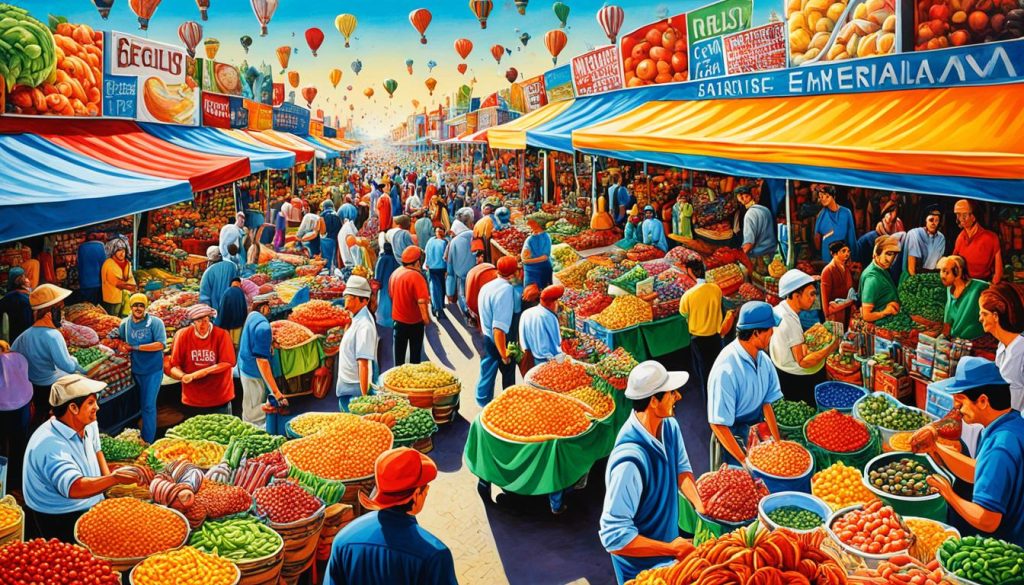My journey into global business has shown the big gap between home and abroad. The idea of growth beyond borders is exciting. Yet, stepping into international markets brings tough tests not seen in our local scene.
When going global, businesses face many challenges. They must look at market size, growth, politics, and more. Global expansion also brings stronger rivals, including those that know local customers better and have easier distribution. But, with the right strategy, it’s also a chance for big success.
This article will explore how international markets work. We’ll look at what companies need to consider for their growth plans. And, how to beat the fierce competition. Understanding these points will help businesses grab unseen chances and avoid common traps.
Assessing the Attractiveness of International Markets
When looking to go global, companies must check the size and growth chances of the market. They look at how big their customer groups might be. Also, they check if these groups are getting bigger. It’s super important to know the economy of the place and how much money people have to spend. This shows if the market is strong.
Market Size and Growth Potential
Figuring out the international market’s size and chances to grow is key. Companies must see how big their target groups are and if they are growing. Knowing this helps them understand the whole market opportunity and where it’s heading.
Economic Conditions and Disposable Income Levels
The economic scene and how much money people have in the market matter a lot. Places with fast-growing economies and a middle class that can spend more are very attractive. Businesses use these details to check the market’s strength and buying power.
Political Environment and Ease of Doing Business
The political scene and how easy it is to do business in a place are crucial but harder to measure factors. Companies look into things like the legal system, protection for ideas, and how stable the politics are. These invisible details can hugely influence a business’s success in the international market.
Exchange Rate Fluctuations and International Trade

Trading in global markets means facing the ups and downs of exchange rate fluctuations. The money businesses make overseas can end up being worth less because of changing foreign exchange rates. This currency risk is something all organisations must consider when thinking about international trade.
Changes in exchange rates can really affect a company’s finances if they operate in different countries. If a country’s money gets stronger, it decreases earnings from overseas. But if it gets weaker, it makes exporting goods cheaper. Companies need to watch these exchange rate fluctuations closely to lessen currency risk.
“Navigating the complex web of international trade means understanding the critical role of exchange rate fluctuations and their impact on the company’s financial performance.”
To tackle currency risk, businesses can use financial tools to hedge, spread their earnings across many markets, or price things in the local currency. By dealing with exchange rate fluctuations early, firms can become stronger and get more from international trade.
Domestic Competition in International Markets
When companies try to go global, they face tough competition from local firms. These local businesses might know what their customers want better. They also may have easier ways to get their products to these customers.
Local Advantages and Consumer Understanding
Companies already in a market for a long time know their customers well. They understand their culture and what they like to buy. This helps them sell their products in ways that are really appealing to people there. So, for new businesses in these markets, beating this local knowledge can be hard.
Access to Distribution Channels
Another thing local companies often have is good connections to the people who sell their products. They know the best places to sell, who to work with, and how to move their goods. This makes it hard for new businesses to get their products out there.
So, breaking into international markets is a big challenge due to local competitors. Overcoming their deep understanding of customers and effective distribution can be tough. Yet, figuring this out is key for new companies to make it in these markets.
Infrastructure Challenges in International Markets

When businesses go global, they face big challenges with the physical infrastructure. This includes how easy it is to get into, out of, and around the new market. Also, the strength of data and communication systems is vital. These things can really test a company’s global plans.
Transportation and Logistics
Good transportation networks are key for moving products and services between countries. If these networks are weak, businesses can face delays and cost spikes. This hurts how well they can meet customer needs on time and within budget.
Data and Communication Systems
In the digital world, strong data and communication systems are a must for global businesses. These systems help companies share info, work with partners, and keep in touch with customers everywhere. Without them, businesses may struggle to operate globally and adapt to market changes quickly.
Defining Domestic and International Markets
The “domestic market” is where goods and services are sold within a country. Businesses in this market find it easier to distribute and sell due to knowing their local customers well. They also keep their focus within their own borders.
Characteristics of Domestic Markets
Domestic markets cover a smaller area and have simpler laws. This leads to businesses knowing what their customers like and how they buy. They have more control over how they work and sell.
Characteristics of International Markets
On the other hand, “international markets” are beyond a country’s borders. Companies here sell their products or services across countries. This kind of marketing has a larger scope, but it’s harder to manage.
International marketing faces challenges like different languages and cultures. It requires more investment, but it offers a chance to reach more people. This path of selling goods and services can be both tough and rewarding.
It’s important for businesses to know the differences between domestic and international markets. This knowledge helps in making good plans to do well in the world market.
Benefits of Expanding into International Markets
Going international can really boost a company’s growth. It opens up new markets and helps spread risks over different places. Also, it ups the game against competitors. Let’s dive into how companies benefit from this.
Accessing New Markets and Customer Segments
When a business goes international, it can reach new groups of customers it never could before. This leads to more sales and a bigger customer base. It also makes the business less dependent on just one country, making it more stable.
Diversifying Business Portfolio and Risk
Expanding abroad makes a business less risky. Instead of putting all its hopes in one market, it’s spread out. This means if one country’s economy tanks, the business has others to rely on. It becomes stronger and able to face challenges better.
Increasing Competitive Advantage
Selling on a global scale can make a company stand out. It gets to learn from and work with different people worldwide. This leads to new ideas, technologies, and ways of working. All of which can put it ahead of its rivals back home.
Similarities Between Domestic and International Marketing
Even though domestic and international marketing are quite different in size and challenges, they share some crucial features. In both kinds of markets, companies need to use consistent marketing plans. These plans make sure that all their marketing actions and platforms work together well.
Integrated Marketing Strategies
For both local and global markets, using an integrated marketing strategy is key. This means blending all marketing parts, like ads and PR, to send one clear brand message. By doing this, businesses can make their marketing stronger and reach customers more effectively. This leads to a smoother customer journey with the brand.
Risk Management and Market Conditions
Handling risks and being ready for market changes are also critical in domestic and international marketing. Companies face challenges both at home and abroad, like economic fluctuations and policy changes. They must be able to spot and handle risks to stay strong and competitive, no matter where they operate.
Differences Between Domestic and International Marketing
Domestic and international marketing have both similarities and differences. These differences include the size of the market and the kinds of customers. Also, international marketing needs more money and resources because it spans many countries. It also involves meeting varied legal standards.
Geographical Scope and Target Markets
Domestic marketing focuses on one country. This lets companies target a specific local market and its people easily. On the other hand, international marketing reaches across countries with different cultures and rules. So, companies have to use many strategies to connect with various global customers.
Financial Investment and Resource Allocation
Marketing worldwide costs more than focusing on just one country. To do this, companies need to spend on research, changing products for new markets, and setting up sales networks. They also face issues with different currencies and taxes. Handling these challenges calls for careful planning and smart management.
Legal and Regulatory Compliance
Marketing in different countries means dealing with lots of laws and rules. Each place has its own set of legal and tax requirements. Companies must know these and follow them closely. Ignoring these rules could lead to big fines and business troubles.
International markets are often more competitive than domestic markets

Going global means facing intense competition, unlike what you meet at home. Local rivals might be a step ahead, thanks to knowing their customers better and having strong distribution ties. So, stepping into the global scene poses big challenges for any business.
By entering a new market, you’re up against firms already on the inside track. They understand what the people there want and have solid local connections. Breaking through these barriers isn’t easy, especially when working to claim your space in markets you’re new to. The battle for domestic markets is hard, with established players holding much of the ground.
To win in competitive international markets, detailed planning and smart moves are crucial. It’s about knowing your competition well and finding ways to stand out. Working closely with local partners and tailoring your offerings to suit their tastes can boost your chances. This approach helps you find a place and grow profitably in your chosen markets.
Scaling Local Brands for International Success
Businesses aiming to grow their local brands internationally need a global outlook. They must understand that what works at home might not go down well abroad. It’s vital to research markets and understand cultures to make sure the brand’s message, style, and content connect with people from different countries.
Adopting a Global Mindset
It’s not easy taking a brand from local to global. This journey requires a major shift in thinking, from focusing on home turf to the entire world. Companies need to be flexible. They should tweak what they offer and how they speak, based on the specific needs of each new market.
Culturally-Relevant Creativity
To truly make an impact, marketing materials must be fine-tuned to fit each culture. This means understanding what matters to the people you’re trying to reach. From values to preferences, the more a brand ‘gets’ its audience, the more authentic its message becomes. And that means connecting with the locals on a deeper level.
Language and Visual Considerations
Changing how you talk and what you show in ads is key to global branding. Getting translations right and knowing local ways of saying things helps deliver the right message. The same goes for visuals. It’s important that colours, images, and symbols in your ads are not only suited for the global market but also respect local traditions and customs.
Communication Across Globalised Teams
When your brand goes global, good communication within your teams is a must. Sharing best practices, using the right tools, and understanding each other’s view go a long way. These efforts ensure everyone is on the same page, no matter where in the world they are.
Understanding Local Rules and Regulations
Dealing with foreign laws and regulations is a major challenge for any brand going global. Brands must do their homework and play by the local rules. This helps avoid legal trouble and keeps the brand’s identity and integrity intact worldwide.
International Trade and Market Competitiveness

International trade lets people buy and sell goods and services across borders. This can greatly impact how competitive markets are. By importing and exporting, countries can access items not found locally. It helps bring down prices for people by offering a wider selection of cheaper goods and services.
Imports, Exports and Market Access
Imports and exports help nations connect with a huge variety of goods and services. This global trade can make markets more competitive. For instance, importing rare or expensive products can make them more affordable for shoppers. Plus, selling local items worldwide can make a country’s products known to new customers. This increase in business can lead to more innovation and competition at home.
Comparative Advantage in International Trade
The idea of comparative advantage shows how nations can make the most of global trade. They focus on making what they’re good at. Then they swap these goods with others. This way, everyone gets products more efficiently and at better prices.
Criticisms of Comparative Advantage Theory
The theory of comparative advantage is often praised for explaining the good sides of global trade. Still, it’s not liked by everyone.
Rent-seeking behaviour is when some groups in a nation try to keep special rules that help their own businesses. They might ask their government to put up barriers like taxes or bans on foreign products. Doing this can stop the bigger improvements in efficiency and productivity that trading freely and focusing on what we’re best at could bring.
Rent-Seeking Behaviour and Protectionism
When people or groups try to get favours from the government instead of working and creating, it’s called rent-seeking. This can lead to the adoption of policies, like taxes or limits on how much can be imported, that protect home-grown companies. Such acts can help these businesses in the short run. But, in the long term, they can make an economy less effective and stop it from growing as much by messing up with how competition should work.
Critics say that the comparative advantage idea doesn’t consider the real-life issue of rent-seeking and how politics might change what is traded. They argue that the good things about trading freely might not actually happen because of groups with special interests wanting to keep things as they are. They’re not open to the exciting changes that can come when trading openly and focusing on unique things.
Benefits of International Trade and Investment
International trade and investment boost economies. This happens as countries focus on their strengths to trade efficiently. Such trade leads to better economic growth and efficiency worldwide.
Economic Growth and Efficiency
Countries excel by producing goods they’re best at. They then trade these for others’ goods which they can’t easily make themselves. This boosts global economy productivity. It results in cheaper products, better life quality, and quicker economic growth.
Foreign Direct Investment Opportunities
Moreover, trading internationally allows for foreign investments. This brings in expertise, foreign money, and more jobs. The host country sees potential growth in its GDP. Handling foreign businesses and investments offers new resources, technologies, and ways of managing. This helps countries develop their economies further.
Free Trade vs Protectionism Debate
There’s an ongoing debate about free trade and protectionism in the world. Free trade means there are few limits to what can move between countries. This lets markets work together around the world. It makes things like goods, services, and money move freely. Proponents say this helps us buy more things, creates competition, and grows economies.
However, protectionists believe some limits are needed in trade. They think rules can fix problems in the market. These rules might be tariffs, subsidies, or quotas. Their goal is to help local businesses not to lose out to foreign ones. This way, they say, more jobs stay at home and key industries grow stronger.
The fight between free trade and protectionism is a big deal in economics. Countries are more tied together now, making the balance between these two ideas tricky. Governments try to balance helping their countries’ economies with protecting their people’s interests. It’s not an easy problem to solve.











